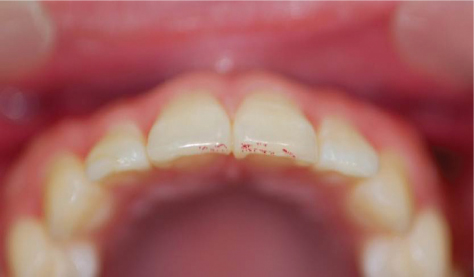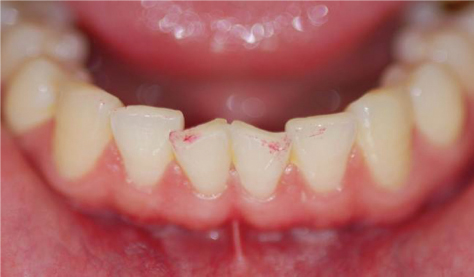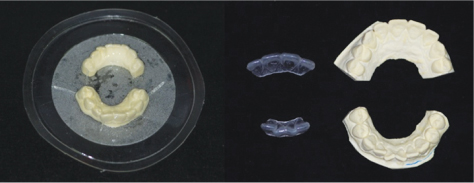Restor Dent Endod.
2012 Mar;37(1):54-60. 10.5395/rde.2012.37.1.54.
An embouchure aid for saxophone player
- Affiliations
-
- 1Biomaterials & Tissue Engineering Lab., Dankook University, Cheonan, Korea. alkydes@dankook.ac.kr
- KMID: 1995685
- DOI: http://doi.org/10.5395/rde.2012.37.1.54
Abstract
- This study aims to introduce the method that can relieve vibrating forces to oral environment by making an embouchure aid. Thin plastic crown forms were fabricated to prevent tooth abrasion and irritation to lip mucosa for the saxophone player. After application to the player, the most comfort form was chosen and delivered to 3 professional saxophone players. After 5 mon, the players responded to the survey. This embouchure aid did not disturb playing and gave comfort to lower lip. In general, the players preferred thin soft type and thought it caused little effect on sound. Far too little attention has been paid to the problems encountered by single-reed wind instrumentalist who suffer from tooth abrasion and irritation to lip mucosa. The embouchure aid not only prevent tooth damage but also diminish the discomfort of tight embouchure.
Keyword
Figure
Reference
-
1. Teal L. Some fundamentals for the saxophone. Music Educ J. 1938. 25:50–51.
Article2. Herman E. Dental considerations in the playing of musical instruments. J Am Dent Assoc. 1974. 89:611–619.
Article3. Engelman JA. Measurement of perioral pressures during playing of musical wind instruments. Am J Orthod. 1965. 51:856–864.
Article4. Gualtieri PA. May Johnny or Janie play the clarinet? The Eastman Study: a report on the orthodontic evaluations of college-level and professional musicians who play brass and woodwind instruments. Am J Orthod. 1979. 76:260–276.5. Department of Physics, University of Illinois. Pignotti D. Input impedance spectrum for a tenor sax and a Bb trumpet. updated 2011 Dec 2. Available from: http://online.physics.uiuc.edu.6. Fuhrimann S, Schüpbach A, Thüer U, Ingervall B. Natural lip function in wind instrument players. Eur J Orthod. 1987. 9:216–223.
Article7. Yeo DK, Pham TP, Baker J, Porters SA. Specific orofacial problems experienced by musicians. Aust Dent J. 2002. 47:2–11.
Article8. Herman E. Orthodontic aspects of musical instrument selection. Am J Orthod. 1974. 65:519–530.
Article9. Porter MM. Dental problems in wind instrument playing. 2. Single-reed instruments-the lip shield. Br Dent J. 1967. 123:441–443.10. Porter MM. Dental problems in wind instrument playing. 3. Single-reed instruments-restorative dentistry. Br Dent J. 1967. 123:489–493.11. Krivin M, Conforth SG. An embouchure aid for clarinet and saxophone players. J Am Dent Assoc. 1975. 90:1277–1281.
Article12. Cremmel R, Frank RM. Pulpe syndrome of wind instrument players. Rev Fr Odontostomatol. 1971. 18:1027–1037.13. Porter MM. The embouchure and some of its endodontic problems. J Br Endod Soc. 1975. 8:27–28.
Article14. Gunst V, Huybrechts B, De Almeida Neves A, Bergmans L, Van Meerbeek B, Lambrechts P. Playing wind instruments as a potential aetiologic cofactor in external cervical resorption: two case reports. Int Endod J. 2011. 44:268–282.
Article15. Gambichler T, Boms S, Freitag M. Contact dermatitis and other skin conditions in instrumental musicians. BMC Dermatol. 2004. 4:3.
Article16. Barkvoll P, Attramadal A. Recurrent herpes labialis in a military brass band. Scand J Dent Res. 1987. 95:256–258.
Article17. Metzger F, Haccuria A, Reboux G, Nolard N, Dalphin JC, De Vuyst P. Hypersensitivity pneumonitis due to molds in a saxophone player. Chest. 2010. 138:724–726.
Article18. Lodha S, Sharma OP. Hypersensitivity pneumonitis in a saxophone player. Chest. 1988. 93:1322.
Article19. Inoue A, Shoji A, Yashiro K. Saxophonist's cane reed cheilitis. Contact Dermatitis. 1998. 39:37.
Article20. Cheshire WP. Trigeminal neuralgia in wind musicians. Headache. 2006. 46:1458–1460.
Article21. Lee WY, Choi SH, Kim SH. Clinical study on the effect of wind instrument playing on periodontal conditions. Jour Periodont Imp Sci. 1994. 24:390–396.22. Bergström J, Eliasson S. Alveolar bone height in professional musicians. Acta Odontol Scand. 1986. 44:141–147.
Article23. Korea customs serivce: Current trend in trading of the musical instrument. updated 2011 August 25. Available from: http://www.customs.go.kr.24. Bergström J, Eliasson S. Dental care habits, oral hygiene, and gingival health in Swedish professional musicians. Acta Odontol Scand. 1985. 43:191–197.
Article25. Bergström J, Eliasson S. Dental health in professional musicians. A radiographic study in dental conscious subjects. Swed Dent J. 1985. 9:225–231.
- Full Text Links
- Actions
-
Cited
- CITED
-
- Close
- Share
- Similar articles
-
- Nonunion of a Stress Fracture Through the Olecranon Epiphyseal Plate in an Adolescent Judo Player: A Case Report
- Reliability and Validity of the Embouchure Dystonia Severity Rating Scale
- Fiddler's Neck Accompanied by Allergic Contact Dermatitis to Nickel in a Viola Player
- The Characteristics of a Research Network for Radiation Oncology in Korea
- Application of Automated Insulin Delivery in Korean Clinical Practice







